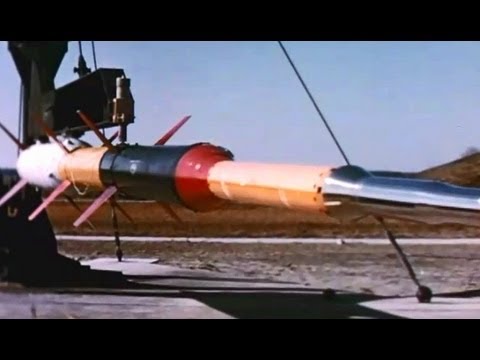more at
A 5-stage solid fueled Jason sounding rocket (aka Argo E-5) is the launch vehicle for high altitude research tests. Color, silent.
“Research by the NACA Pilotless Aircraft Research Division on the 5-stage solid rocket. Tests appear to have taken place at Wallops Flight Facility, originally part of Langley Research Center.”
NASA Langley Research Center film # L-328
Public domain film from NASA, slightly cropped to remove uneven edges, with the aspect ratio corrected, and mild video noise reduction applied.
Jason was an American sounding rocket with 5 stages. The Jason was launched 22 times in 1958. The Jason could carry a payload of 125 pounds (57 kg) to an altitude of 500 mi (800 km). The launch thrust was 82,100 pounds-force (365 kN), the launch mass 7,340 lb (3330 kg), the diameter 58 centimeters (23 in) and the length 17.5 meters (57 ft).
Also known as Argo E-5, this research vehicle was made by Aerolab for the Air Force (AFSWC) for use in the Jason program, which measured the trapped radiation from the Argus nuclear tests in the latter half of 1958. It was launched from Cape Kennedy, Wallops, and Puerto Rico. It consisted of an Honest John first stage plus a Nike stage plus another Nike stage plus a Recruit stage plus a T-55 as the fifth stage…
also see:
A sounding rocket, sometimes called a research rocket, is an instrument-carrying rocket designed to take measurements and perform scientific experiments during its sub-orbital flight. The rockets are used to carry instruments from 50 to 1,500 kilometres (31 to 930 mi) above the surface of the Earth, the altitude generally between weather balloons and satellites (the maximum altitude for balloons is about 40 kilometres (25 mi) and the minimum for satellites is approximately 120 kilometres (75 mi)). Certain sounding rockets, such as the Black Brant X and XII, have an apogee between 1,000 and 1,500 kilometres (620 and 930 mi); the maximum apogee of their class. Sounding rockets often use military surplus rocket motors. NASA routinely flies the Terrier Mk 70 boosted Improved Orion lifting 270–450 kilograms (600–990 lb) payloads into the exoatmospheric region between 100 and 200 kilometres (62 and 120 mi)…
Etymology
The origin of the term comes from nautical vocabulary to sound, which is to throw a weighted line from a ship into the water to measure the water’s depth. The term itself has its etymological roots in the Spanish and French word for probe, which is “sonda” or “sonde”, respectively. Sounding in the rocket context is equivalent to taking a measurement.
Design
A common sounding rocket consists of a solid-fuel rocket motor and a science payload. The freefall part of the flight is an elliptic trajectory with vertical major axis allowing the payload to appear to hover near its apogee. The average flight time is less than 30 minutes, usually between five and 20 minutes. The rocket consumes its fuel on the first stage of the rising part of the flight, then separates and falls away, leaving the payload to complete the arc and return to the ground under a parachute.
Advantages
Sounding rockets are advantageous for some research due to their low cost, short lead time (sometimes less than six months)[3] and their ability to conduct research in areas inaccessible to either balloons or satellites. They are also used as test beds for equipment that will be used in more expensive and risky orbital spaceflight missions. The smaller size of a sounding rocket also makes launching from temporary sites possible allowing for field studies at remote locations, even in the middle of the ocean, if fired from a ship.
Research applications
Sounding rockets are commonly used for:
– Research in aeronomy, which requires this tool for in situ measurements in the upper atmosphere
– Ultraviolet and X-ray astronomy, which require being above the bulk of the Earth’s atmosphere
– Microgravity research, which benefits from a few minutes of weightlessness on rockets launched to altitudes of a few hundred kilometers..
Other uses
The term sounding rocket is sometimes colloquially used to refer to the firework rockets used during the Diwali festival in India. The reference derives from these rockets making a high-pitch whistling sound during their ascent.

